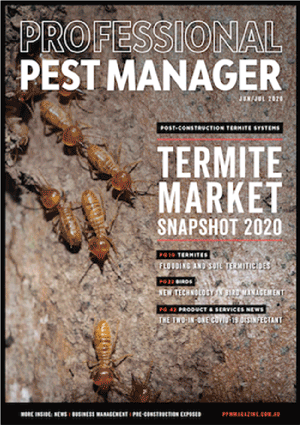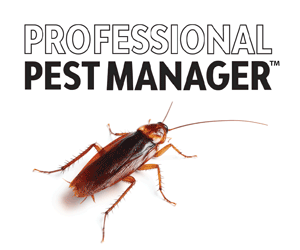A review of the latest research on termite baiting, including a look at potential new bait actives and novel baiting strategies.
How do termite baits work?
For anyone wanting to understand how termite baits work, leading termite researcher Assoc. Prof. Thomas Chouvenc from the University of Florida has written a comprehensive overview, focusing on the performance of baits on Coptotermes spp.1
Many pest managers will understand that any individual termite worker that eats bait containing a CSI (chitin synthesis inhibitor) will die when it next tries to moult. This is because CSIs prevent the production of chitin, an essential component of the termite’s cuticle, which therefore prevents the development of a new cuticle. However, recent research has mapped out how bait is transferred within the colony, with trophallaxis between nestmates and cannibalism of moulting workers (which return to the central nest to moult) being the main routes of transfer. Once the CSI has impacted the queen and larvae around the 20-30 day mark, the colony is already doomed, even though complete colony elimination may take three months or more.
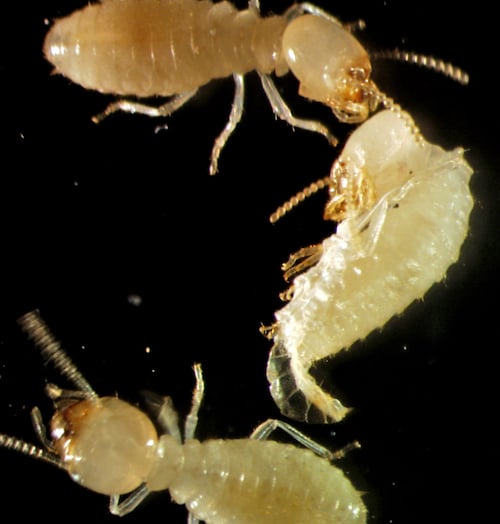
Although our understanding of the mode of action of termite baits has improved, more research is needed to understand any differences between the mode of action of the various CSIs and their differential effects on the various termite species (see page How Do Termite Baits Work? for a detailed review).
Bait station placement distance and its impact on discovery
Many bait products recommend in-ground bait stations to be placed not more than 3 m apart. Still, many pest managers question whether termites would tunnel between the bait stations without being intercepted by the bait stations? Researchers have attempted to address this by assessing the impact of distance between bait stations on bait interception time.2
Using a large laboratory foraging arena, with two bait stations placed 3 m apart, and termites released halfway in between the bait stations, the results showed that Coptotermes formosanus termites found at least one of the bait stations in an average time of 21 days. Following on from this, the researchers evaluated whether having bait stations closer together reduced the time to discovery. It did – but bait stations had to be placed 45 cm apart before the reduction in discovery time was significant. The researchers suggested that this fourfold increase in the number of bait stations required would be prohibitively expensive for the marginal benefit achieved.
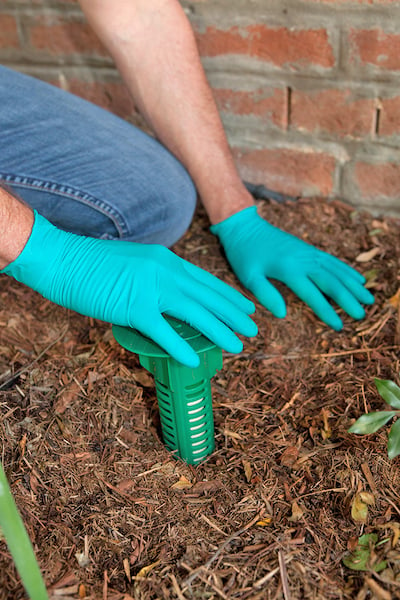
They also noted that on discovery of a bait station, the termites significantly increased tunnelling activity. This behaviour suggests that C. formosanus is optimised to find clumped resources and therefore the placement of additional stations around a station that has been intercepted may have some benefit. The authors also note that all termite species have the same foraging behaviour, and therefore bait placement strategies may need to be modified for different species.
Area-wide termite elimination
With its proven colony elimination performance, termite baiting has the potential to eliminate termites from an area, not just a single property. Since the appearance of termite baits as a termite control product, there have been a number of area-wide termite management projects, primarily in the US. Perhaps the most well-known program was ‘Operation Full Stop’, a termite management initiative to protect structures within the historic French Quarter in New Orleans.3 New Orleans is considered an area of high termite pressure, with Coptotermes formosanus being the key termite species.
The program ran from 1998 to 2012 and offered property owners the choice of installing a baiting system (72.45%) or having a soil treatment. Performance was assessed by measuring termite activity in in-ground monitoring stations placed throughout the quarter and using sticky traps on streetlights to assess alate numbers. The number of active monitoring stations and number of colonies contributing to the alate numbers decreased during the program. The concern was that once the program stopped that the termite numbers would once again increase.
At the end of the program, alate trap counts continued annually. The results show that alate numbers and the number of colonies contributing to these alate numbers had continued to decrease since the end of the program (Figure 1). A survey of properties recorded that just over 50% of properties still had baiting programs in place and a number of these had converted to the durable baiting products. Whilst no longer considered an area elimination project, the benefits of widespread baiting in New Orleans continues to have a significant impact on the termite population.
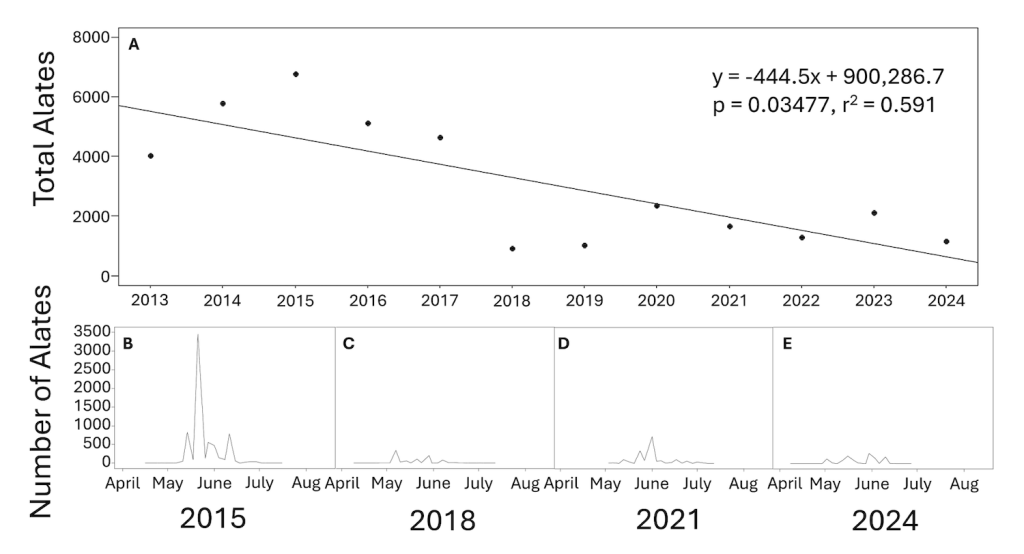
However, an area-wide termite elimination project in Spain has been deemed a success (see Termite Baits – A Tool for Area-wide Elimination of Termites). After five-year baiting programs at five different towns across the Iberian Peninsula, infestations of Reticulitermes spp. have been eliminated and the towns have remained termite free for more than ten years.4 Although these areas have lower termite pressure compared with areas such as New Orleans, and Reticulitermes spp. are less aggressive termites, the program demonstrated that with complete surveys to map the infestation area, good management and accurate implementation, area-wide elimination of termites is possible in certain situations.
Termite baiting in Asia
One of the key groups of termite pests in Asia are the Macrotermitinae, the fungus-growing termites. These species farm a symbiotic fungus that is integral to the processing of food within the colony. They are one of the more challenging termite species to control, as the performance of termite baits is inconsistent. Interception of bait stations is low, feeding on termite baits is intermittent, and elimination is not always achieved.5
Researchers have proposed five reasons for this:
- Sporadic foraging behaviour, with termites regularly abandoning food resources;
- High colony density means numerous small colonies. So even if a colony is eliminated, other colonies in the area can move in (giving the impression the bait hasn’t worked);
- Mature workers don’t moult, which prolongs the time taken to achieve colony elimination;
- The symbiotic fungus impacts CSI efficacy, both delaying the time taken before ingestion by the termites and potentially detoxifying the CSI;
- The palatability of cellulose baits may be sub-optimal.
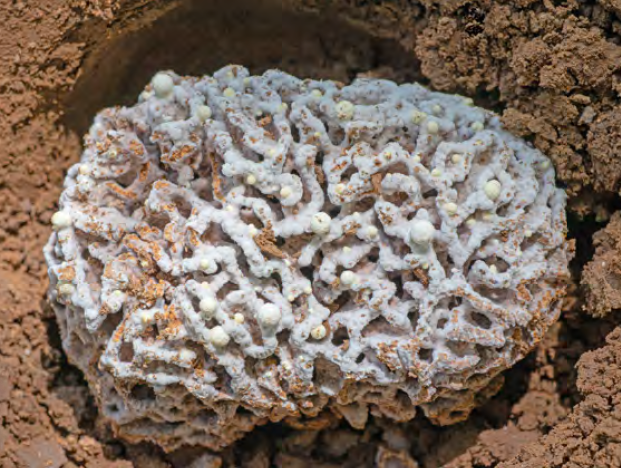
Fungus growing termites have a broad diet and a pure cellulose bait may not be particularly attractive. The researchers highlighted that the biggest knowledge gap is understanding how the symbiotic fungus processes CSIs and what is transferred to the termites on feeding.
Laboratory efficacy of different chitin synthesis inhibitors
Chitin synthesis inhibitors (CSIs) have a similar mode of action. However, an increasing amount of data indicates that the different CSIs do not deliver the same level of performance on the various termite species. A recent laboratory study on three different species, Coptotermes gestroi, Globitermes sulphureus and Macrotermes gilvus (fungus-growing termite) illustrates this observation.6 The study utilised three commercial baits based on bistrifluron, chlorfluazuron and hexaflumuron and recorded worker mortality over four weeks.
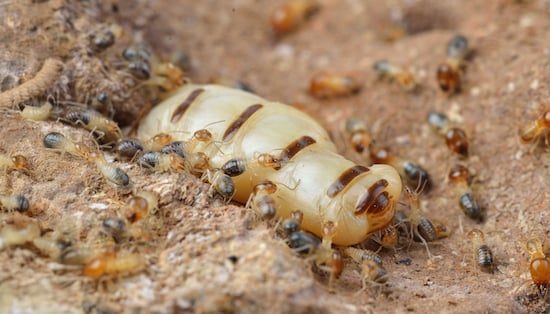
All three baits delivered 100% mortality of M. gilvus within three weeks, whilst the average mortality across all baits by the end of week three was 90% for C. gestroi and 58% for G. sulphureus. The performance of hexaflumuron bait was similar on all species, but both chlorfluazuron and bistrifluron delivered higher mortality on M. gilvus than G. sulphureus. This result highlights the differential performance, which cannot be attributed solely to palatability, although the reason for different performance of the different CSIs is not known.
It is also important to consider that efficacy trials on individual workers rather than whole nests can give different results. For example, all baits tested here gave 100% mortality on M. gilvus workers, yet bait performance in the field can be variable when offered to whole colonies of M. gilvus with their fungus gardens intact.
Evaluating the effect of CSIs on termite gut microbiota
Describing the mode of action of CSIs has been primarily focused on its impact on chitin synthesis, which disrupts the creation of new cuticles and therefore kills termites when they try to moult. It also impacts the queen as she lays unviable eggs. However, the different CSIs deliver differing levels of performance and the same CSI can deliver variable performance on different termite species, suggesting that the mode of action of CSIs has not been fully characterised. One area of research is exploring the impact of CSIs on the termite gut
microbiota. Researchers in Malaysia have characterised the gut microbiota of three different termite species – Coptotermes gestroi, Globitermes sulphureus and Macrotermes gilvus – with the last two species being Termitidae (higher termites).7
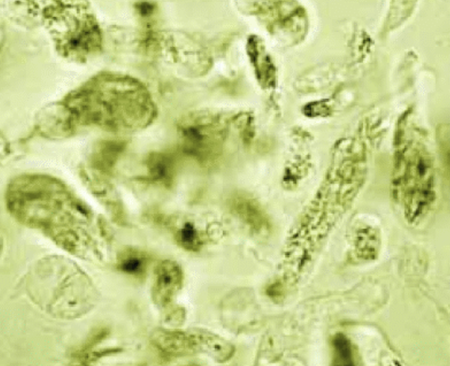
As expected, fundamental differences were found in the gut microbiota of all species, but particularly between the Termitidae and C. gestroi (Heterotermitidae). G. sulphureus and M. gilvus exhibited a greater number of species compared to C. gestroi, with the authors suggesting that the lack of protists in the Termitidae being due to their replacement with bacteria and archaea, to facilitate wood digestion. After exposure to CSIs, the gut microbiota in all three termites changed, with all three showing an increased number of species, with significant changes in relative abundance (some increased, some decreased) of a few groups of bacteria. However, the bacteria groups showing these changes in relative abundance were not the same for each termite species. The authors concluded that the termite gut bacterial community is very susceptible to CSI treatment and further research is required to determine the impact of these changes on termite biology and health.
Termite baiting – A clear winner in IPM programs
Prof. Nan-Yao Su has recently published an ‘Overview of the Development of Termite Baits Over the Past Three Decades’.8 Prof. Su is uniquely positioned to provide the summary along with his insights, having been involved in bait development work and research from the outset. The paper provides a great summary of baiting technology – essential reading for all termite professionals. A key focus of the paper was highlighting the environmental benefits of termite baiting.
Prof. Su notes that, “Since the commercialization in 1995, termite baits have been introduced in 32 countries, protecting over 3.7 million homes and reducing pesticide use by more than 11,100 metric tons.”
Comparing termite baiting to soil treatments, baits use approximately 750 times less insecticide (0.043 kg/hectare) than soil termiticide applications (32.4 kg/hectare). The targeted activity of CSIs versus the broad-spectrum activity of the insecticides used in soil treatments further reduces their environmental impact. From a toxicology point of view, CSIs as a rule are many times less toxic than soil termiticides. For example, noviflumuron has an LD50 on rats some 33 times lower than fipronil. He suggests that such data gives baits a clear benefit in IPM programs, especially as sustainability is becoming increasingly important.
References
1 Chouvenc, T. (2025) ‘How do termite baits work? implication of subterranean termite colony demography on the successful implementation of baits’, Journal Of Economic Entomology. https://doi.org/10.1093/jee/toae243
2 Gazdick, K. et al. (2025) ‘Subterranean termites (Coptotermes formosanus [Blattodea: Rhinotermitidae]) colonies can readily intercept commercial inground bait stations placed at label-prescribed distance’, Journal of Economic Entomology. https://doi.org/10.1093/jee/toae259
3 Cottone, C.O. et al. (2025) ‘The impact of Operation Full Stop, New Orleans, Louisiana on suppressing Formosan subterranean termite (Coptotermes formosanus) colonies: 10 years later’, Journal of Economic Entomology. https://doi.org/10.1093/jee/toae297
4 Mora, D. and Hernandez-Teixidor, D. (2025) ‘Large-scale elimination of subterranean termite colonies of the genus Reticulitermes Blattodea: Heterotermitidae) from town centers in Spain’, Journal of Economic Entomology. https://doi.org/10.1093/jee/toaf039
5 Chiu, C.-, I. and Li, H.-F. (2025) ‘Challenges in baiting to manage fungus-growing termite colonies’, Journal of Economic Entomology. https://doi.org/10.1093/jee/toae276
6 Shamsuri, Q.S. and Ab Majid, A.H. (2024) ‘Laboratory efficacy and performance of several type of chitin synthesis inhibitors (CSIs) towards three species of subterranean termite (Blattodea:Rhinotermitidae, Termitdae)’, International Journal Of Tropical Insect Science, 44(3), pp.1245–1254. https://doi.org/10.1007/s42690-024-01231-7
7 Shamsuri, Q’Aini S. and Majid, A.H.A. (2024) ‘16S rRNA metabarcoding of gut microbiota between untreated and Chitin Synthesis Inhibitors bait treated in three subterranean termite species’, Gene Reports, 36. https://doi.org/10.1016/j.genrep.2024.101985
8 Su, N.-Y. (2025) ‘An overview of the development of termite baits in the past 3 decades’, Journal of Economic Entomology. https://doi.org/10.1093/jee/toae224
With baiting the proven technique for colony control, especially where the nest cannot be located, significant ongoing research is looking into both improving the palatability and efficacy of termite baits and maximising the performance from baiting systems.
Are Caulk Baits the Next Innovation in Termite Baits?
Termite baits are an ideal product for the control of active termite infestations, as they are proven to deliver colony control. However, bait placement on active termite feeding sites is not without its problems. Firstly, fixing a bait station or bait pouch to the active feeding site can be challenging. Then, even if you do manage to attach a bait station, it becomes a visible reminder that the homeowner has a termite problem – something that neither the pest manager nor homeowner really wants. Of course, for some homeowners, it also becomes too tempting to open the bait station and have a look! There is an opportunity for a new type of termite bait that overcomes these negatives, which is why a significant amount of development work is currently focused on injectable baits, either in gel or caulk formats.
After initial success with a fluid bait on Coptotermes formosanus colonies, a prototype caulk bait was developed by Corteva Agriscience for field evaluation on Coptotermes gestroi. Palatability is a key factor in baiting success so researchers from the University of Florida carried out field trials comparing the caulk termite bait with the commercially available Corteva above-ground bait.1

The experimental caulk bait was applied at seven sites: four houses, two offices and a docked boat. Colony elimination was achieved between 3.1 and 13.6 weeks. Although this was numerically a bit quicker than the standard above-ground bait stations, there was no significant difference in the time to elimination in this trial. However, it will be interesting to see whether, with a bigger data set, the speed to colony elimination is faster with the caulk bait. Certainly, the ability to apply directly at feeding fronts and at multiple locations means (hypothetically) that the time to initial feeding and therefore time to elimination should be shorter, as the termites don’t have to ‘find’ the bait.
In-ground and Above-ground Baiting with Coptotermes gestroi
The Asian subterranean termite, Coptotermes gestroi, is native to tropical Southeast Asia, but has spread globally due to human activity. Amongst the Coptotermes species, C. gestroi seems to be unique, in that in-ground monitoring stations are rarely found by C. gestroi workers, rendering in-ground baiting an ineffective control method. Researchers from the University of Florida carried out a field trial to provide direction on the best baiting techniques for Coptotermes gestroi.2
In-ground bait stations placed around infested properties, above-ground bait stations placed on feeding sites within buildings, and above-ground bait stations placed on trees with termite activity were all evaluated as control options. As expected from previous studies, the in-ground bait stations proved ineffective, with none of the 83 stations placed around infested structures or trees with nests being discovered.
However, above-ground stations placed at active feeding sites within the same structures were discovered, with elimination of activity achieved within 4-13 weeks. For infested trees, all 12 applications delivered colony elimination within 5-12 weeks.
For C. gestroi management, the authors confirmed that in-ground termite monitoring and baiting was not a suitable management tool, but above-ground termite baiting was a very effective tool in eliminating active termites from buildings and achieving colony control. Although in-ground stations are not suitable as a monitoring tool, due to their unique foraging behaviour (see page opposite), the researchers emphasised the need for comprehensive inspections, in particular inspecting trees around the property for signs of infestation. The authors noted that since C. gestroi appears to infest trees around properties before infesting the property itself, baiting infested trees could be an effective way of reducing termite pressure on the property and preventing potential infestations.
References
1 Su, N-Y and Mullins, A (2023). A comparison between above-ground bait stations and experimental caulk baits for elimination of field colonies of the Asian subterranean termite, Coptotermes gestroi (Blattodea: Rhinotermitidae). Journal of Econ. Ento., 116(5): 1787-1794. https://doi.org/10.1093/jee/toad157
2 Su, N-Y et al. (2023). Elimination of structural and tree infestations of the Asian subterranean termite, Coptotermes gestroi (Wasmann) (Blattodea: Rhinotermitidae) with noviflumuron baits in above-ground stations. Journal of Economic Entomology, 116(3): 909-915.
Time to find in-ground bait stations may vary by season
As we know, termites are sensitive to both moisture and temperature. Finding and utilising food sources is heavily driven by moisture, and warmer temperatures increase feeding rates. However, warming temperatures without higher levels of moisture can cause termites to abandon feeding sites, as it increases the risk of desiccation. Accepting the impact of these environmental factors can have on termite foraging behaviour, it therefore makes sense that these factors could also impact the discovery and exploitation of in-ground bait stations. This is especially the case since in-ground bait stations are installed at the soil surface, an area which is inherently more variable in terms of temperature and moisture level.
Researchers in the US investigated whether installing in-ground termite baits at different times of the year (and therefore under different soil temperature/ moisture conditions) impacted the time taken for them to discovered.1 They carried out their study in California, which is characterised by hot, dry summers and cooler (but still warm), wet winters.
The research team installed termite baits at four different times over a one-year period and measured termite activity every two months for two years. The researchers found that most of the foraging occurred during the cooler, wetter, winter and spring. As a result, bait stations installed at the beginning of winter were found significantly quicker than those installed at the beginning of summer (194 days v 296 days).

In applying these findings to Australia or any other country, it is therefore important to consider the seasonal weather conditions in your area to determine the likely impact on discovery and feeding on in-ground baits. Further still, it highlights the need to consider the localised conditions on the specific property – for example, placing baits in reliably moist, warm conditions will provide the highest chance of hits, but baits placed in dry, sandy soils exposed to sun are likely to have a lower hit rate.
High tech termite monitoring in the forbidden city
Beijing has a temperate climate; summer temperatures can be warm to hot, and winter minimums can get below freezing. Few termite species can survive these temperatures, with the exception of Reticulitermes, with R. chinensis and R. speratus both present. The Forbidden City is palace complex in Beijing with old, culturally and architecturally significant buildings with a high wood content. It is also a heat sink, with temperatures significantly higher than the surrounding city. Two termite attacks have occurred in the Forbidden City in 2006 and 2010. With the temperature increasing due to climate change, the termite risk is likely to increase. To protect the buildings, an area-wide baiting system has been installed protecting 150,000 m2 of buildings using 900 bait stations.

In order to increase efficiency in inspecting the site and to ensure real-time data is obtained – so any attacks can be dealt with as soon as possible – researchers developed a remote monitoring system to receive realtime alerts when bait stations are attacked by termites.2 The trigger is based on electromagnetic induction, with the magnetic field changing when the bait station is attacked by termites. This change in the magnetic field is picked up by an above-ground signal acquisition module that converts the signals to electrical signals to send the information, including GPS information, to the manager for action to be taken.
The intention is to manage the termite risk to the Forbidden City on a site basis, rather than building basis, to keep the site free from termites. The authors of the study believe baiting plus automatic monitoring is the best and most efficient way to provide termite protection.
Fast acting v slow acting termiticides in the laboratory
Typically, bait actives are chitin synthesis inhibitors (CSIs), which are slow acting insecticides that have delayed effect to allow the insecticide to be spread around the nest, to provide complete colony control. However, sometimes, insecticides such as fipronil are added to bait stations to provide control. Although fipronil is generally considered slow acting compared to pyrethroids, it is certainly fast acting, with a different mode of action, when compared to CSIs. Researchers in Korea have investigated the effects of two CSIs and fipronil when applied to a food source, on Reticulitermes speratus in the laboratory.3
Their first trial focused on groups of termites in a petri dish with an insecticide-treated food source (pine). In this trial, the fipronil-treated food source resulted in 100% mortality, with termites dead in a little over five days. In contrast, mortality in the CSI treatments was only around 25% after three weeks. This is perhaps not surprising given the mode of action of the insecticides.
The more interesting trial was the whole colony trials (approx. 12,000 termites), where the main colony was attached to a series of five foraging arenas using lengths of tubing (Figure 1), with each foraging area also containing sub-nests (S). The total foraging distance from the nest to the fifth arena was 20 metres, with the treated bait placed between the third and fourth arenas some 14 metres from the nest. After ten weeks the results were very different to the petri dish trials, in many ways the complete opposite – close to 100% mortality with the CSI treated bait and only around 20% for the fipronil bait.
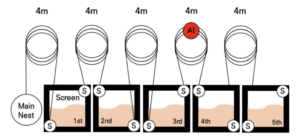
With the fipronil-treated bait, dead termites accumulated in the tubes either side of the bait, until at the two week point, the termites blocked the tube, preventing further access to the bait. This effectively split the colony into two, with termites in arenas 4 and 5 now being isolated from the nest. Back in the nest, eggs continued to be laid and secondary reproductives produced. In contrast, termites feeding on the CSI-treated baits continued to forage on the bait, despite increasing mortality. Back in the nest the production of eggs and secondary reproductive ceased. The authors concluded that their whole colony (planar arena) trials provided a good tool for assessing likely field performance of bait products and that it provided data to support their field observations that termite damage continues in buildings treated with fipronil baits, with colony controlled unlikely to be achieved.
References
1 Sutherland, Andrew & Hubble, Casey & Barber, Molly. (2022). Installation Season May Significantly Impact Time Required for Subterranean Termites to Find and Feed on In-Ground Baits. Insects. 13. 445. 10.3390/insects13050445.
2 Zhang, Guoqing & Gu, An & Zhang, Dayu & Shen, Junfeng. (2022). Risk Assessment and Monitoring of Termites in the Forbidden City under Global Warming. Studies in Conservation. 67. 10.1080/00393630.2022.2059988.
3 Im, Ik-Gyun & Han, Gyu-Seong. (2022). Changes over Time in Activity Patterns of Reticulitermes speratus (Blattodea: Rhinotermitidae) Fed Fast- or Slowacting Termiticides. BioResources. 18. 131-142. 10.15376/biores.18.1.131-142.
The mode of action of chitin synthesis inhibitors
Chitin synthesis inhibitors are proven to deliver colony control in termites. The key to their success is their delayed mode of action (only activated when termites moult) and that termites exhibit trophallaxis, which allows for any CSI ingested by foraging termites to be distributed through the colony. However, in the field, as only a relatively small proportion of the workers actually forage, the question arises as to what proportion of foragers actually need to feed on a CSI bait for colony elimination to occur?
Working with four-year-old laboratory colonies of Coptotermes gestroi, researchers exposed workers to termite bait for five days before being returned to their colonies.1 The number of exposed workers that were returned to the colonies was varied to create a proportion of exposed workers varying from 0% to 5% of the overall worker population. Colony elimination was confirmed for all colonies where 5% of the worker population had fed directly on bait and two thirds of colonies where 2.5% of the worker population had been exposed. The results confirmed that only a small percentage needs to have fed on a bait for colony elimination to occur and for C. gestroi, it appears that somewhere between 2.5% and 5% of the worker population would be sufficient.
The primary action of chitin synthesis inhibitors is on the moulting process. Workers die when they moult, and younger workers die before the older workers as they have a shorter inter-moult period. Indeed, the workers in higher termites, which do not moult, are not directly affected by the bait. The developing larvae also actively moult and are eliminated early in the baiting process. However, researchers wanted to know whether the lack of replacement brood was due to the queen being unable to lay viable eggs, or that she laid the eggs but the eggs hatched and were unable to moult from the first instar.
Working with founding pairs of Coptotermes gestroi in the laboratory, Chouvenc and Lee (2021) exposed these new colonies to CSI from day one.2 The impact was profound. Even by day ten, the number of eggs produced by the CSI-exposed colonies was significantly lower than the control colonies. By day 20 the number of eggs in the treated colonies started to decline and whilst control colonies started to produce larvae by day 35, the treated colonies never produced larvae. After 110 days, all the treated colonies were dead, although it is unclear as to whether the death of the queen and king was due to lack of alloparental care, as a direct consequence of the CSI exposure, or both.
The researchers concluded that the queen is indeed impacted by ingesting CSI and is unable to lay viable eggs, contributing to the collapse of the colony.
Independent confirmation of Coptotermes gestroi colony control by novaluron
Although a range of chitin synthesis inhibitors are used in termite baits, most of the research has used the older chitin synthesis inhibitors such as hexaflumuron and noviflumuron. Independent data on new chitin synthesis inhibitors, such as novaluron, is of course more limited. Although proven on Reticulitermes species and Coptotermes formosanus in the US, its performance on Coptotermes gestroi has not previously been evaluated. Researchers in the US have confirmed novaluron as an effective colony elimination active using complete laboratory colonies of C. gestroi in foraging arenas (Figure 1) where feeding sites were 15 metres from the nest.3 The study demonstrated that the termites had stopped feeding within six weeks and colony elimination had occurred within three months.

Baiting fungus-growing termites
Termite baiting has primarily been a control method for lower termites. Its success against higher termites is more variable. Workers in higher termites do not moult and so this would at least partly explain why bait-affected colonies of higher termites take longer to succumb. However, some of the higher termite species are fungus growers. The fungus is used to digest cellulose material and/or provide a direct food source for the termites, depending on the species. The inclusion of this fungal partner in the processing of food is also thought to impact the passage of the chitin synthesis inhibitor within the colony.
Many of the fungus-growing species are also more sporadic in their foraging patterns, regularly abandoning food sources before they are exhausted. Whilst baiting has been successful in mound-building, fungus-growing termites, where the bait can be applied directly to the mound, dealing with fungus-growing species without a mound can be more problematic.
Researchers in Pakistan investigating the fungus-growing termite Odontotermes obesus demonstrated that larger bait stations are found more easily, experience higher levels of recruitment and suffer from significantly less abandonment than smaller bait stations.4 The researchers thus concluded that in order to get sufficient bait into the colony, large bait stations (around 8 L in volume) would work better for O. obesus and other related fungus-growing higher termites.
Fungus-growing termites are significant pests in Asia, particularly of agricultural crops rather than buildings. Whilst the length of time to achieve eradication in the urban setting is critical, as damage to buildings needs to be arrested as soon as possible, complete elimination in the agricultural setting is less important. Instead, any reduction in crop damage is deemed valuable. However, control methods have to be applied over a large area in order to reduce termite activity. To avoid spraying chemical around food crops and for reduced environmental impact, termite baiting is seen as a preferred option.
Researchers in Taiwan have completed a four-year study assessing the impact of termite baits in reducing the activity of Odontotermes formosanus.5 Using long-lasting termite baits, the number of monitoring baits attacked had dropped by nearly 50% after two years of baiting, and the amount of wood consumed had dropped by 25%. The colonies that had been confirmed as eliminated all had chitin synthesis inhibitor in the fungus gardens. However, the baiting had not eliminated all the colonies in the area. Despite this, the researchers believe the significant drop in wood consumption would translate to a beneficial drop in crop damage. Further work around density and location of bait stations could potentially increase the level of control achieved.
Fungi associated with fungus-growing termites
Termitomyces spp. are the symbiotic fungus associated with the fungus-growing termites (Figure 2).
The fruiting body from the fungus in the fungus gardens appears above ground indicating the presence of a termite nest (Figure 3).


Fungi of Xylaria spp. are saprophytic fungi that grow on the rotten fungus gardens of deceased termite colonies. Their fruiting bodies also appear above ground (Figure 4) and indicate the location of a deceased colony (Figure 5).


Image credit: Images kindly provided by Dr. Jie-Hao Ou/National Chung Hsing University (Figures 2, 3 and 4) and Dr. Chun-I Chiu/Chiang Mai University (Figure 5).
References
1 Gordon, Johnalyn & Velenovsky, Joseph & Chouvenc, Thomas. (2022). Subterranean termite colony elimination can be achieved even when only a small proportion of foragers feed upon a CSI bait. Journal of Pest Science. 95. 1-10. 10.1007/s10340-021-01446-4.
2 Chouvenc, Thomas & Lee, Sang-Bin. (2021). Queen Egg Laying and Egg Hatching Abilities are Hindered in Subterranean Termite Colonies When Exposed to a Chitin Synthesis Inhibitor Bait Formulation. Journal of Economic Entomology. 114. 10.1093/jee/toab200.
3 Chouvenc, Thomas. (2021). Subterranean Termite (Coptotermes gestroi (Blattodea: Rhinotermitidae)) Colony Elimination Through Exposure to a Novaluron CSI Bait Formulation in Laboratory. Journal of economic entomology. 114. 10.1093/jee/toab061.
4 Iqbal, Naeem & Alvi, Abid & Hussain, Mujahid & Saeed, Shafqat & Naeem-Ullah, Unsar & Khan, Alamgir & Abid, Allah. (2020). Foraging behavior and bait station preference in scavenging termite, Odontotermes obesus (Blattodea: Termitidae). Bulletin of Entomological Research. 111. 1-9. 10.1017/S0007485320000693.
5 Chiu, Chun-I & Chuang, Ya-Hui & Liang, Wei-Ren & Yeh, Hsin-Ting & Yang, Hsiao-Ying & Tsai, Ming-Jer & Spomer, Neil & Li, Hou-Feng. (2021). Area-population control of fungus-growing termite, Odontotermes formosanus , using hexaflumuron durable baits. Pest Management Science. 78. 10.1002/ps.6612.
Do termites adjust their diet in response to macronutrients?
Termites may select food based on the quantity present, but do they vary their food intake to achieve a balanced diet? Nutritional ecology theory predicts that omnivores will vary their diet to achieve a balanced intake of nutrients, yet specialist feeders such as termites – which have evolved to feed on a narrow range of foods that match their dietary requirements – are unable to switch between different food types to maintain nutrient intake.
Researchers working with Nasutitermes exitiosus carried out a series of laboratory trials presenting groups of termites with paired food sources: one carbohydrate (cellulose) and one protein.1 Termites collected the same total amount of food irrespective of the foods presented, but took less of higher protein foods. As expected for a specialist feeder, termites did not adjust their diet to a specific carbohydrate to protein ratio. Unlike many ant species, which vary the level of protein in their diet depending on the amount of brood present, in this trial the presence of different castes (including larvae) did not impact intake or diet choice.
Do termites adjust their diet in response to micronutrients?
Foraging theory suggests that animals will preferably choose food that contains nutrients that are lacking in their diet. With termites feeding exclusively on cellulose material (wood and other plant material), their diet is typically lacking in protein and some micronutrients (vitamins and minerals). For example, the ash content of wood is between 0.2 to 2.1%, whereas the ash content of termites is between 3.72% and 9.9% depending on species. The main elements of ash are phosphorous, potassium, calcium and magnesium with a range of trace elements. With this in mind, Suhara (2020) investigated whether termites preferentially feed on food sources higher in these ash elements.2
Using filter paper disks dosed with one of the test solutions, covering a range of doses, the disks were then dried before being fed to groups of termites (workers and soldiers) collected from field colonies of Coptotermes formosanus. Trials were carried out in both multiple choice (1250 termites) and no-choice (100 termites) feeding situations.
In the multiple choice feeding situations, only one treatment – dipotassium phosphate – significantly increased consumption relative to the untreated control, actually increasing consumption by 2.5 times. However, in the no-choice study, the termites appeared to eat the same amount of paper disks, whether or not they contained dipotassium phosphate. It could be that although dipotassium phosphate is preferred to other food sources, it does not boost overall intake. The researcher suggested that the small number of workers used in the no-choice study may have influenced this result. Nevertheless, the conclusion was that dipotassium phosphate has the potential to increase bait palatability but that field trials with actual bait impregnated with dipotassium phosphate are necessary.
New potential bait actives?
Some pest managers swear that the addition of Gatorade – blue Gatorade to be precise – improves the ‘hit rate’ and palatability of termite baits. Certainly there is some evidence to suggest it can increase the rate of tunnelling in treated sand.3 But interestingly, the latest research indicates that erythritol, the sweetener used in many sugar-free soft drinks, actually appears to cause mortality in termites.4
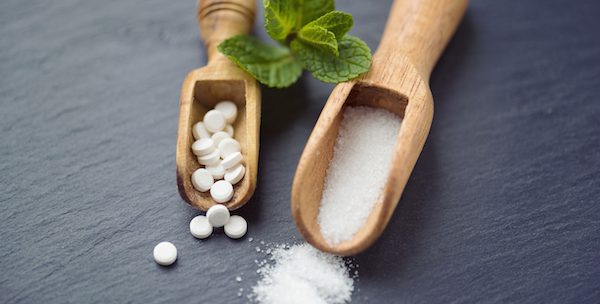
Researchers at Drexel University in Philadelphia investigated whether erythritol – which is known to cause increased mortality when ingested by some insects – might have potential as a novel termite bait active. Workers of the eastern subterranean termite (Reticulitermes flavipes) were fed paper soaked in different concentrations of erythritol. The termite mortality measured at eight days after bait presentation was positively correlated with concentration, with the higher concentrations achieving over 80% mortality after eight days.
The termites consumed paper even with the highest level of erythritol and the researchers observed no avoidance behaviour in choice bioassays versus untreated paper, no matter the concentration of erythritol. As such, the researchers recommended that research should continue into the potential of erythritol as a termite bait active.
Whether or not erythritol sees the light of day as a commercial termite bait, these results highlight the risk of adding supplements with unknown properties to termite baits. Without testing, there is no way of knowing how even the most benign chemical may impact termite behaviour. It is for this reason that bait manufacturers generally test their bait products with distilled water, to avoid adding any impurities to the bait matrix. As always, there is a reason to follow the label.
New insecticides actives do not come along very often, so some termite researchers are taking a different approach. Since higher termites are very much reliant on their gut symbionts, which include a range of bacteria, it makes sense to see whether antibiotics could have a role in termite control.
After extracting gut bacteria from Microcerotermes diversus, the researchers screened a range of antibiotics on the cultivated bacteria.5 As a result, two antibiotics, chloramphenicol and nalidixic acid, were assessed for their impact on termite behaviour. When fed on wood treated with antibiotics, termites showed a significant reduction in health, as measured by reduced tunnelling and reduced running speed. However, the presence of the antibiotics did result in a reduction of the amount of wood consumed, potentially due to an adverse taste or smell, or potentially food aversion through a feedback mechanism.
Some interesting early results, but a lot more research is required to establish whether antibiotics have a role to play in termite control. It is certainly an area of interest, as control of higher termites such as Nasutitermes can be a lengthy process using traditional baits.
Only add bait to one in-ground station?
When attempting colony elimination with baiting it is best practice to add bait to all bait stations that have active termites and to keep replenishing with bait until the termites stop feeding. But is this really necessary? Researchers from the Universiti Sains Malaysia set out to see whether colony elimination could be achieved with greatly reduced bait usage.6
The researchers mapped out activity at six sites (five in Penang and one in Kedah) using a combination of in-ground and above-ground monitoring stations. To confirm they were only dealing with one nest at each site, and mapping its foraging territory, the researchers used a mark recapture technique whereby termites were captured at one bait station and fed filter paper to stain them blue. They were subsequently released and their presence in bait stations at the site recorded. All sites were confirmed to have one colony of Coptotermes gestroi.
The researchers added chlorfluazuron bait to only one of the in-ground stations and monitored activity in all the bait stations every two weeks until the colony had been eliminated. At each two-week inspection, the bait in the treated bait station was replenished if required. At all six sites, colony control was successfully achieved within 4 to 8.6 weeks using less than 300 g of bait.
With the time to elimination no slower than the traditional method of adding bait to all active stations, adopting this strategy would provide some savings in both time and bait use. However, the key issue is knowing that the termite activity in all stations is from the same colony. For the pest manager in the field, carrying out a mark recapture study is not really an option. In summary, it remains best practice to bait all active bait stations in case more than one colony is involved.
Can you eliminate termites from an area by baiting?
In-ground baiting systems are normally placed around the perimeter of a structure to intercept termite activity. The bait will then eliminate the attacking colony. However, it is more than likely that other termite colonies in the area will be attacking the home. Placement of additional bait stations in potential ‘hotspots’ around the property may pick up some of these additional colonies, but it represents a somewhat hit and miss approach. A group of US researchers decided to investigate whether baiting can be used to eliminate termites from an area and keep the area termite free.7
The study involved installing 100 in-ground monitoring stations at two sites, with five metres in between each station, covering an area of just over 2000 m2. At each site, half the area was wooded and half the area was pasture. Over a two-year period, the colonies and activity in the areas were mapped. After two years, a novaluron bait was added to the bait stations in the wooded area at site A. The use of monitoring stations without bait, as a control, continued at site B. Termite activity at both sites was recorded for a further 18 months.
Prior to treatment, the sites hosted between 8-14 colonies (or approximately 55-100 colonies per hectare) of Reticulitermes flavipes and Reticulitermes virginicus. Of the 11 active colonies present in the treatment area at the time of baiting, seven colonies were no longer active within two months after treatment. By the end of the study, some 18 months later, no activity was recorded in the treatment site. In contrast, of the 12 colonies identified at the control site before baiting commenced on the treatment site, seven were still active at the end of the study.
The researchers concluded that it is indeed possible for wide-area baiting to eliminate termites from an area and that the location can be kept termite free as long as bait is present. The use of long-lasting baits in conjunction with regular termite inspections would be the most efficient method of keeping the area termite free.
References
1 Poissonnier, L.-A., Simpson, S.J., Dussutour, A., Buhl, J., 2020. Regulation of macronutrient intake in termites: A dietary self-selection experiment. JOURNAL OF INSECT PHYSIOLOGY 120. https://doi.org/10.1016/j.jinsphys.2019.103983
2 Suhara, H., 2020. Using phosphate to increase feeding consumption in termite Coptotermes formosanus. JOURNAL OF WOOD SCIENCE 66. https://doi.org/10.1186/s10086-020-01932-w
3 Cornelius, M.L and Osbrink, W.L.A (2008). Effect of bait supplements on the feeding and tunnelling behavior of the Formosan subterranean termite (Isoptera: Rhinotermitidae). Sociobiology 51(2):497-511.
4 Caponera, V. et al (2019). Erythritol Ingestion Causes Concentration- Dependent Mortality in Eastern Subterranean Termites (Blattodea: Rhinotermitidae). Journal of Economic Entomology 113(1): 348–352.
5 Mousavi, S.Q., Bandani, A.R., Alaie, E., 2020. Combination of antibiotics and chitin synthesis inhibitors for the control of Microcerotermes diversus (Isoptera: Termitidae). JOURNAL OF ASIA-PACIFIC ENTOMOLOGY 23, 957–962. https://doi.org/10.1016/j.aspen.2020.08.001
6 Umar, W.A.S.W., Ab Majid, A.H., 2020. Efficacy of Minimum Application of Chlorfluazuron Baiting to Control Urban Subterranean Termite Populations of Coptotermes gestroi (Wasmann) (Blattodea: Rhinotermitidae). INSECTS 11. https://doi.org/10.3390/insects11090569
7 Shults, P., Richardson, S., Eyer, P.-A., Chura, M., Barreda, H., Davis, R.W., Vargo, E.L., 2021. Area-Wide Elimination of Subterranean Termite Colonies Using a Novaluron Bait. INSECTS 12. https://doi.org/10.3390/ insects12030192
Further reading:
Information on termite treatments.
Behaviour of bait-affected termites

